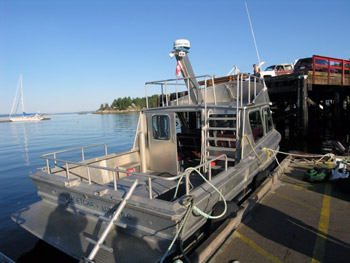
British Columbia, Canada
by Glen Cowley
We crested the knoll and were rewarded. Below us ran drift-wood artistry crafted along the tanned body of a broad beach welcoming the incoming tide. And this on a hot, clear September day with the Coast Mountains, blue hued in jagged array, gazing down. Not a soul in sight.
Welcome to Savary Island; originally named “Ayhus” by the Sliammon (Tla’amin) First Nation people, meaning double-headed serpent.
This was the picture I had in mind from all the glowing descriptions I heard regarding this unique isle; famed for waters claimed the warmest north of Mexico. And this was a time to come; when the press of summer tourism is fading; when land, sea and sky reclaim their timeless ownership.
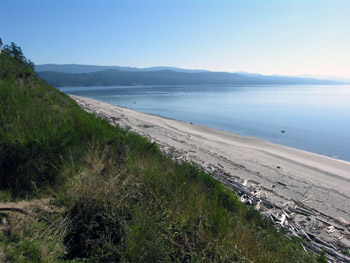 Our journey to the isle, first recorded as Savary’s Island by Capt. George Vancouver in 1792, began at the ferry dock in Comox, Vancouver Island. An hour twenty later we were rolling off the Queen of Burnaby into Powell River back dropped by the serrated teeth of the majestic coastal mountain range. A half hour north landed us in Lund, a village dating from the 1880s when the two Thulin brothers from Sweden set up shop and named the community after one back home. Free parking is at a premium here but paid parking is available for daily fee of $7.00 at Dave’s parking lot. Savary emerged, a rich green line across the horizon, as we strolled the village boardwalk. Then we were off to our evening abode; a bed and breakfast south of Powell River.
Our journey to the isle, first recorded as Savary’s Island by Capt. George Vancouver in 1792, began at the ferry dock in Comox, Vancouver Island. An hour twenty later we were rolling off the Queen of Burnaby into Powell River back dropped by the serrated teeth of the majestic coastal mountain range. A half hour north landed us in Lund, a village dating from the 1880s when the two Thulin brothers from Sweden set up shop and named the community after one back home. Free parking is at a premium here but paid parking is available for daily fee of $7.00 at Dave’s parking lot. Savary emerged, a rich green line across the horizon, as we strolled the village boardwalk. Then we were off to our evening abode; a bed and breakfast south of Powell River.
The following morning found us at the Lund water taxi ready and waiting for the 9 am service to Savary. During the summer months service is hourly but otherwise it is irregular, dependent upon demand. We clambered aboard the sturdy little craft along with luggage, dogs and 8 others, expecting a casual chug across the channel. We cleared the marina lazily then the engines exploded into life, the bow rose and the waters fell swiftly away as we blasted into the clear. In ten minutes we were scrambling out upon the government dock gazing at the long sandy arm of a forever beach. A cluster of boats floated near the shoreline.
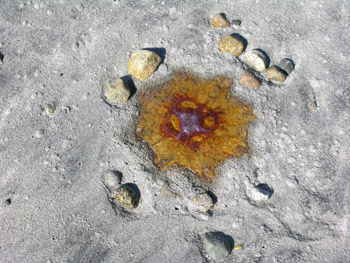 Stretched along the south shore, where we came ashore, were a line of substantial homes bordering the dirt road which we learned ran the length of the island, about 7.5 kilometres (.8 to 1.5 kilometres wide). Vehicles crowded a haphazard parking lot though few were to be found trundling along the low maintenance dirt roadways with the waning of summer. Admiring homes we walked as far south as the road allowed, drinking in views of beach and mountain. Perhaps appearing a tad bemused as we poured over a brochure we were rescued by a local resident who filled us in on the what’s and wherefore’s of Savary. She and her husband were just closing up their home for the season as were many of the locals; however there are a solid few who call Savary home full time and garner the fruits of civilized solitude in this stunning setting.
Stretched along the south shore, where we came ashore, were a line of substantial homes bordering the dirt road which we learned ran the length of the island, about 7.5 kilometres (.8 to 1.5 kilometres wide). Vehicles crowded a haphazard parking lot though few were to be found trundling along the low maintenance dirt roadways with the waning of summer. Admiring homes we walked as far south as the road allowed, drinking in views of beach and mountain. Perhaps appearing a tad bemused as we poured over a brochure we were rescued by a local resident who filled us in on the what’s and wherefore’s of Savary. She and her husband were just closing up their home for the season as were many of the locals; however there are a solid few who call Savary home full time and garner the fruits of civilized solitude in this stunning setting.
The island, though long known, did not feel the feet of many until it was subdivided into lots in 1910. Despite its small size there are 1750 lots giving it the highest lot density of any island in the Salish Sea. An early settler, Jack Green, built a cabin and store here in 1886, only to be murdered along with his business partner in 1893. The culprit was tracked down in a long distance, international chase and ended his days at the bad end of a rope.
Sunny Sandy Savary: A History of Savary Island 1792-1992
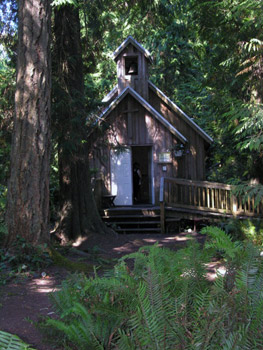 She told us of the Savary Island B & B; a single floor sprawling log building we had just passed and admired. There had been a couple hotels on the island – The Savary, built in 1914 survived until it burned down in 1932 and the Royal Savary Hotel at Indian Point which was demolished in 1982. Now B & Bs, cabin rentals and a lodge offer accommodation options. The listed permanent population of 100 balloons to a couple thousand in the summer.
She told us of the Savary Island B & B; a single floor sprawling log building we had just passed and admired. There had been a couple hotels on the island – The Savary, built in 1914 survived until it burned down in 1932 and the Royal Savary Hotel at Indian Point which was demolished in 1982. Now B & Bs, cabin rentals and a lodge offer accommodation options. The listed permanent population of 100 balloons to a couple thousand in the summer.
Steam ships serviced the island until the 1950s when water taxi from Lund took over. Now most arrive via the taxi, personal craft or float planes.
I hadn’t realized, given my Google image and the many words about sandy beaches, how hilly Savary is. We crossed the width of the island, climbing significantly in the process, and were rewarded with a magnificent vista as we crested above south beach. Below us ran a long lonely strand strewn with driftwood; broad still even with a slow incoming tide. The sun pounded down as we began the challenging, but not overly so, switch back down the hill until our feet found level ground. High above houses peeked through the trees but the shoreline was all ours.
Off came the shoes and we padded the beach enjoying the cool seawash over feet. In a dead standing tree a turkey vulture coolly watched us; I checked my pulse and took a sip of water.
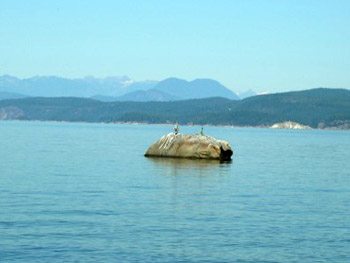 A black dot on the water proved a large curious seal. Masked Killdeer complained as they wheeled about behind us and, usually solitary, Loons swam about in a group. We wore no watches. Time took on its own rhythm. Afterwards we sat on a log gazing towards the sea and enjoyed a snack. Never ceases to amaze me how food tastes better in such settings.
A black dot on the water proved a large curious seal. Masked Killdeer complained as they wheeled about behind us and, usually solitary, Loons swam about in a group. We wore no watches. Time took on its own rhythm. Afterwards we sat on a log gazing towards the sea and enjoyed a snack. Never ceases to amaze me how food tastes better in such settings.
We had all day to explore but the Sun was ensuring it was not to be ignored and compelled us to occasionally seek the shady arms of the forest.
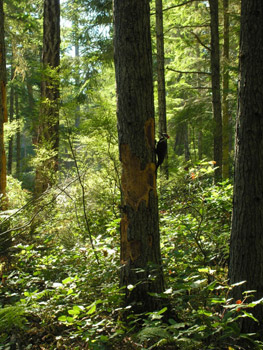 Striking out for the north beach and Mermaid Rock we returned to the dirt road, gloriously titled Vancouver Boulevard, running the spine of the island, and climbed to the height of land which was to take us through a protected and treed sand dunes section, devoid of development due to its fragility. Few cars and people frequented the roadway which felt much like a shady park walk.The takity takity tack of a noisy Piliated woodpecker echoed through the still forest; proving so intent on attacking his tree he took no notice of us. The protected zone is home to 10,000 year old sand dunes. The island is eroding steadily at both the north and south ends.
Striking out for the north beach and Mermaid Rock we returned to the dirt road, gloriously titled Vancouver Boulevard, running the spine of the island, and climbed to the height of land which was to take us through a protected and treed sand dunes section, devoid of development due to its fragility. Few cars and people frequented the roadway which felt much like a shady park walk.The takity takity tack of a noisy Piliated woodpecker echoed through the still forest; proving so intent on attacking his tree he took no notice of us. The protected zone is home to 10,000 year old sand dunes. The island is eroding steadily at both the north and south ends.
Before reaching the protected zone we came across Rigger’s Pub/Bistro which was partially open; that is the manager was out back, the door was open and the coffee was on. We learned the bistro was the central gathering place for the island and serves alcohol, though it is not formally considered a pub. Of atmosphere it had plenty to share. Among the eclectic adornments of the walls was an old newspaper account of the aforementioned murder of Jack Green. Not far from the bistro stood a multi-denominational chapel peaceful and secluded amid the trees, open to one and all.

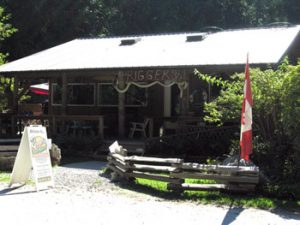 At the trail head we encountered a panting ascending trio winded, but encouraging us to venture to the beach below. It proved worth the effort and much easier than our earlier experience at South Beach. Once again we had a beach to ourselves. We found ourselves a comfortable log and sat to absorb place and ambiance. Mermaid Rock offshore was adorned with two figures; both stoic in their pose but much differing in their essence. It appeared an oddly-stanced Great Blue Heron was doing his best to impress the green hued statue of a mermaid despite her consistent indifference. Ah, the pain of unrequited love.
At the trail head we encountered a panting ascending trio winded, but encouraging us to venture to the beach below. It proved worth the effort and much easier than our earlier experience at South Beach. Once again we had a beach to ourselves. We found ourselves a comfortable log and sat to absorb place and ambiance. Mermaid Rock offshore was adorned with two figures; both stoic in their pose but much differing in their essence. It appeared an oddly-stanced Great Blue Heron was doing his best to impress the green hued statue of a mermaid despite her consistent indifference. Ah, the pain of unrequited love.
Afar we could see the final arch of the north end of the island but bone weary and cooked by the Sun we chose to forego the final leg and saunter back to await the water taxi We had already determined Savary a place of return in order to experience its charms more fully.
As we sped back across the channel in the water taxi, aptly named Comintagetcha, I anticipated a cool brew at the Lund Hotel, which has been standing in one form or another since 1895. Its many years having brought with them tales of hauntings and the paranormal it fit with the timelessness of the place and the lingering view of Savary; emerald upon the horizon.
If You Go:
There are no public campsites, washrooms or garbage facilities on Savary so you must come prepared. There is also no public source of drinking water and come the end of summer all services effectively shut down. The best way to see the entirety of the island in a day is by bicycle of which there are summer rentals and the prospect of availability in early September (best to check).
Water taxi – lundwatertaxi.com It is best to call ahead to confirm the schedule and reserve a seat. There are Savary Island maps/brochures available at the office.
Information on Savary re: accommodations and more: savaryca.bravehost.com
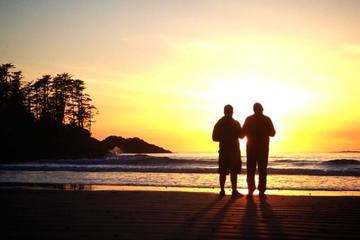
2-Day Tofino Tour from Vancouver
About the author:
Since 1994 Glen Cowley has parlayed his interest in sports, travel and history into both books and articles. The author of two books on hockey and over sixty published articles (including sports, travel, features and biographies) he continues to explore perspectives in time and place wherever travels and circumstances take him. From the varied landscapes of British Columbia to Eastern Canada and the USA, the British Isles, Germany, Switzerland, the Netherlands, Greece and France he has found ample fodder for features. His present endeavours see him working on a book on unique pubs on Vancouver Island; a sober experience. Contact: windandice@shaw.ca
All photos by Glen Cowley:
Water taxi at Lund
South Beach
Jelly fish on South Beach
Chapel
North Beach – Mermaid and Heron
Piliated Woodpecker
Riggers pub/bistro



Leave a Reply
You must be logged in to post a comment.